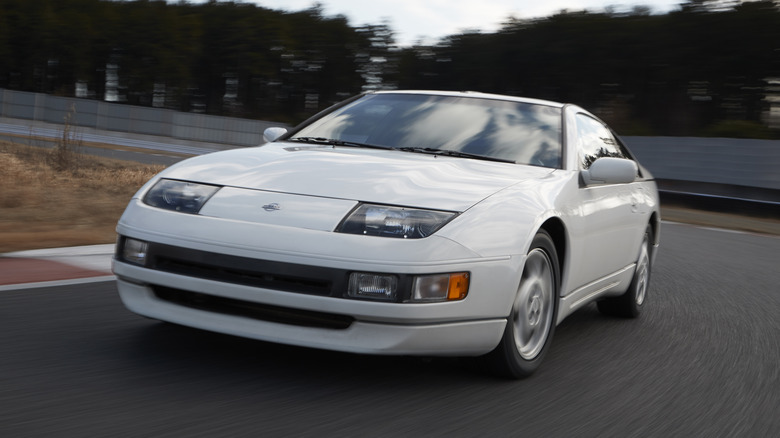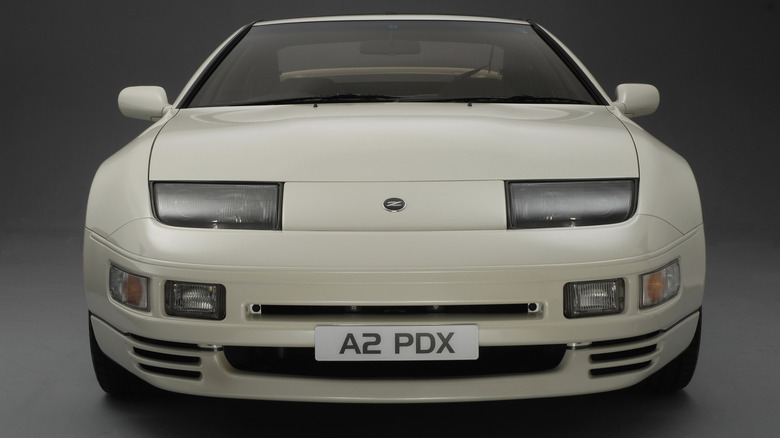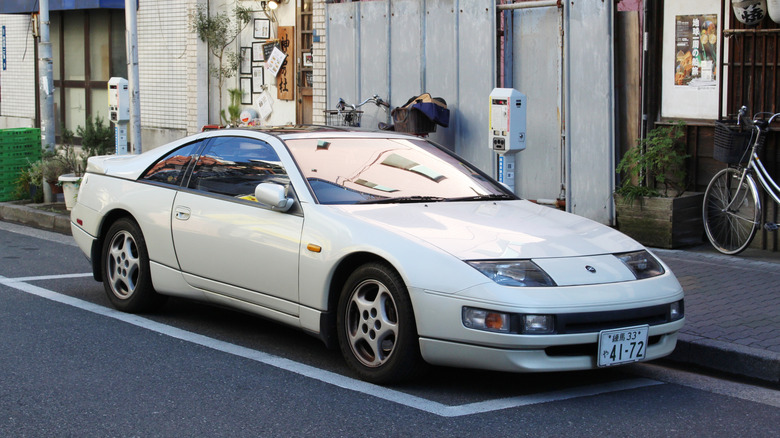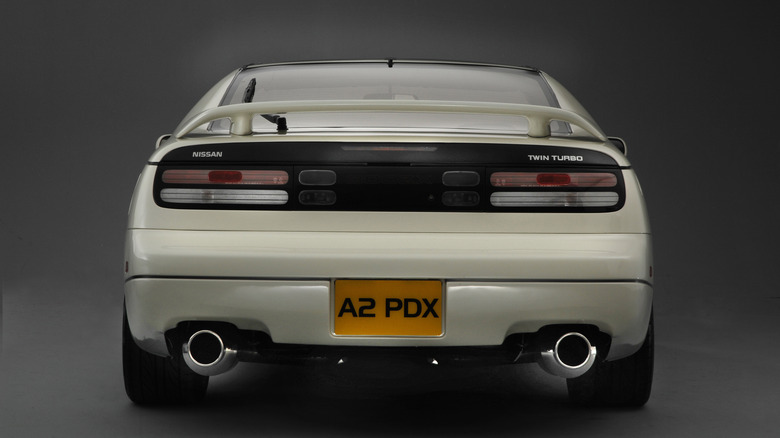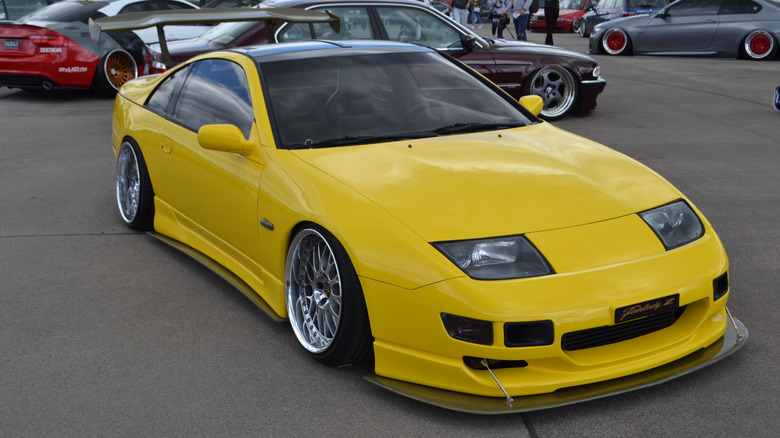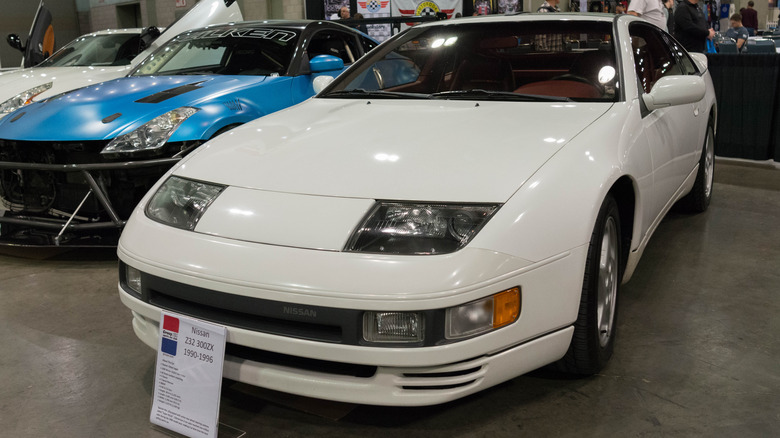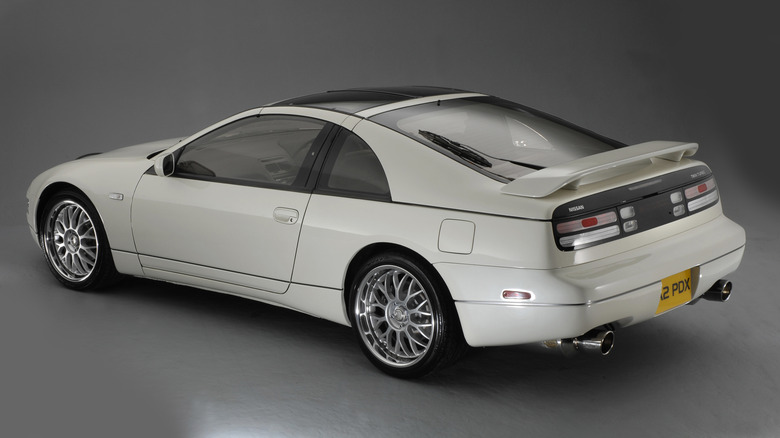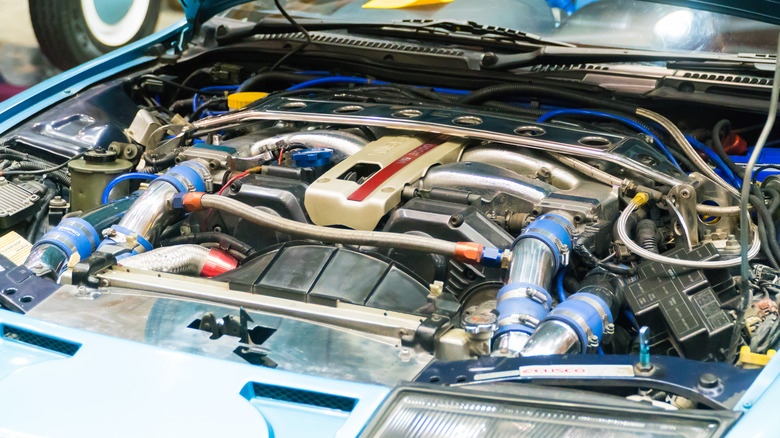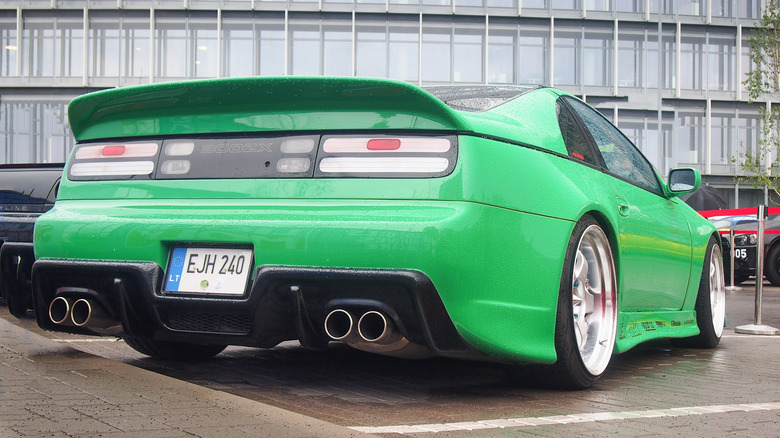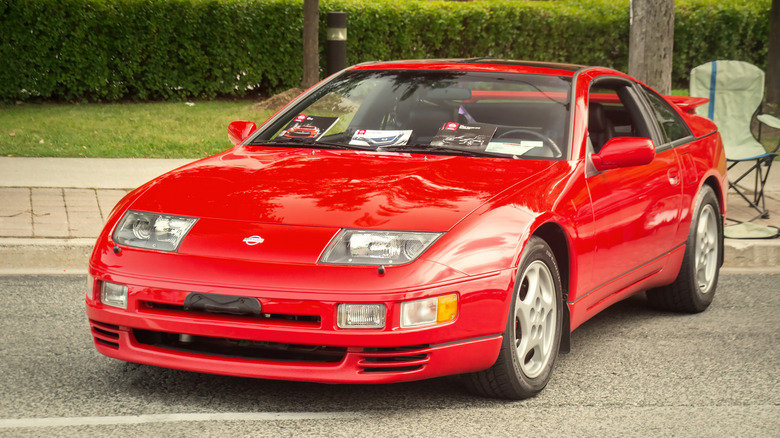Everything You Should Know Before Buying A Nissan 300ZX
Japanese sports cars from the '90s are getting less and less affordable as the supply of examples in good condition decreases and nostalgia levels for the "golden age" of JDM reach all-time highs. One of the few iconic cars from the era that's still relatively affordable is the Nissan 300ZX Z32, the car that's often credited with single-handedly rescuing Nissan's Z line of cars. Its combination of power, handling, and looks proved that Nissan could still build halo cars that could compete with the big European automakers, even if the previous decade or so of its "sports car" output had been anything but sporty.
The 300ZX offered supercar-level performance at a significant discount to many of its rivals, although by the end of its production run, a strong yen had made it less of a bargain than it once was (via MotorTrend). Sales slumped, and the car was killed off in the U.S. in 1996, without an immediate successor. It might not have hit the sales targets that Nissan had hoped for in its later years, but today it's looked back on as one of the greatest Z cars ever produced, and arguably one of the best Nissans of all time, period. As collector demand for the car has risen in recent years, so have resale prices. There are still plenty of opportunities to snap up a 300ZX for a great price though, as long as you know what to look for.
Design of the Z32 300ZX
The design of the 300ZX can be accredited almost entirely to its lead designer, Toshio Yamashita. He reportedly gained the nickname "Mr. Yadashita" during his time working on the 300ZX (with "yada" roughly translating from Japanese as "no, no, no") because of his tendency to ignore other ideas from his design team and push forward with his own vision (via Jalopnik). That vision included smoother, sleeker lines than any previous Z car, with a focus on designing something that would work well in America.
Sometimes, Yamashita's design ideas would clash with engineering limitations at the time, but the designer found a way to solve most of the problems. For example, Jalopnik reports that Yamashita was personally responsible for finding and suggesting the 300ZX's headlight projectors to the engineering team, which were smaller than anything the company had used before and so could fit within the 60-degree sloping headlights. Those headlights were so innovative that Lamborghini borrowed them for the Diablo, but they would have never existed if it wasn't for the persistence of Yamashita. The end result of such persistence was a car that brought Nissan's Z line very much back to the cutting edge of design, with the looks to compete with the very best rivals from Japan, Europe, or elsewhere.
What's the 300ZX like to drive?
The previous-generation Z31 300ZX had gained a reputation for being much more show than go. One Car and Driver review from the era even called it a "flabby, disco-poseur's" car that deserved to be "laid to rest in a special graveyard reserved for stretch slacks, musk colognes, and slap-on chest hair." That same review notes that the new Z32 300ZX was a revelation in comparison, with a smooth, refined driving feel, yet enough power to more than keep up with anything else in its price bracket. The car was originally launched in naturally-aspirated form only, but a year later, a twin turbo variant was unveiled, which packed even more power.
Despite relying on forced induction, the turbo version of the car suffered from virtually no turbo lag at all, according to Hagerty. Turbo models also gained Nissan's innovative HICAS four-wheel steering system, which was also used on the R32 Skyline GT-R, and allowed the car to turn more sharply at high speed. For reference, the top-spec 300ZX boasted the same output as the Ferrari 348 released the same year, but for a fraction of the price (via MotorTrend).
Turbo vs. non-turbo
As the undisputed faster option, twin-turbo variants of the car tend to command a higher price tag than their naturally aspirated siblings. That's not to say that either was slow: The naturally aspirated 3.0-liter V6 still produced 220 horsepower and mated to the five-speed manual, it could reach 0-60 mph in 6.7 seconds (via Hagerty). The twin turbo, however, boasted a maximum output of 300 horsepower and could sprint from a standstill to 60 mph in just 5.5 seconds, making it the fastest car in its price bracket hands down. Only the manual version twin turbo broke the 300 horsepower barrier though, as the automatic version saw the engine detuned to 280 horsepower.
Suffice it to say, the most desirable variant for collectors today is the manual twin turbo 300ZX, but prices of good condition examples have started to rise out of the reach of most collectors. Sales data from Bring a Trailer shows that naturally-aspirated examples can still be picked up for under $10,000 if you're lucky, with two examples selling for $7,600 and $9,360 in November and December 2022 respectively. Twin turbo versions usually sell for well over double that figure, especially if they've been well maintained and haven't been modified.
Modified vs. stock
For years, the 300ZX was both readily available on the used market and temptingly cheap, and as a result, many examples were modified to some degree. Some builds, Autocar notes, can see cars modded to produce well over 400 horsepower, and in many cases, those cars will also come with aftermarket body kits, exhausts, or wheels. Buying someone else's project car is always going to be a gamble, if nothing else because it's impossible to know how well those modifications were installed, and what other internal bits were affected in the process.
Generally, it's always better for collectors to avoid cars with any significant modifications at all, even if it means paying a premium. Resale is almost always negatively impacted if a car has non-standard parts, especially when powertrain or visual modifications are involved. On the flip side, if you're the kind of buyer that's planning on adding your own twist to the car anyway, buying a 300ZX that's already modded can net you a significant discount over paying resale for a fully-stock example. Just be sure to watch out for cheap parts or shoddy workmanship. It's no Rolls-Royce, but the technological complexity of the 300ZX combined with the tight gaps in the engine bay mean it's far from the easiest car to work on, and as a result, there will be plenty of project car owners that will have cut corners at some point during their build.
Resale value
Buying a car for yourself is one thing, but it's always good to keep in mind the car's potential future resale value should you want to sell it later down the line. As previously mentioned, it's generally a good rule of thumb to assume that aftermarket modifications will damage a car's resale value, with originality being a key area of interest for many collectors. Rare variants or special editions will also almost invariably add value to a car, so if you can get your hands on one of the 300 "Commemorative Edition" '96 300ZXs, you're onto a winner. They're not easy to come by, though, and expect to pay north of $40,000 on the rare occasion one is listed for sale.
The other factor to consider in resale is value trends for different "regular" variants. Not only is the twin-turbo version of the 300ZX faster to drive, it's also the variant that's more rapidly rising in value. Data from Hagerty show that values for the 1990 model year 300ZX twin turbo have risen 10.2% year-to-date, while prices for the non-turbo 2+2 Targa from the same year have risen a mere 1.2% in value. As such, the Turbo is the better driver's car and probably also the better financial investment — at least, if you have the cash to cough up for an example in good condition in the first place.
Differences between model years
The 300ZX didn't change much over the course of its production run, but it's worth being aware of the differences between each model year, so you know what you're getting. The car arrived in early 1989 as a 1990 model year, with the turbo debuting at the end of the year, notes MotorTrend. Both turbo and naturally aspirated variants initially had a targa top roof, but in 1991, a "slicktop" fixed roof coupe was also offered. This slicktop was also marginally faster than its targa top lineup sibling. Only a few minor tweaks were made for 1992, with a driver's-side airbag made standard across the whole range, and turbo models gained a power-adjusted driver's seat.
The convertible 300ZX was launched in 1993, and 1994 saw the introduction of a new HICAS design and more airbags added as standard. Very little was changed in 1995 save for the launch of the high-performance SMZ edition, which was tuned by Steve Millen and boosted power up to 365 horsepower while retaining the factory warranty. By 1996, sales were in decline and the 300ZX was about to be axed in America, and the last model year also saw variable cam timing scrapped. MotorTrend reports that '96 USDM cars were slightly less powerful even though Nissan advertised them as identical to previous model years.
Common faults: powertrain
If it's looked after right, the 300ZX's VG30DE engine will happily run for a couple hundred thousand miles without issue, but improper maintenance can cause all manner of problems. When buying a car, it's important to check that the engine has received a new timing belt every 60,000 miles or so, and the turbo seals have been checked, as they can start leaking between 60,000 and 80,000 miles, according to Car and Driver. It's also been reported that injectors can stick and cause misfires, and heat damage from various engine components can cause problems with the wiring loom.
The clutch on the manual version can last up to 70,000 miles, but depending on who's driving, half that figure might be enough to wear it out. At the very least, be sure to establish when the clutch was last changed on the car, and if it's over 50,000 miles or so ago, be prepared to shell out for a new one in the near future. Replacing things like the clutch will invariably be a costly procedure, so it's best to find a local specialist who's well-equipped to deal with any auxiliary issues that might arise when the car comes in for work. Doing repairs yourself will save money, but this isn't a car for wrenching novices, and wannabe mechanics will quickly find themselves out of their depth if they're too ambitious.
Common faults: everything else
Whether they're novices or simply trying to cut corners, Car and Driver reports that some owners will turn off the HICAS four-wheel steering system in a bid to keep maintenance costs down. Earlier model years (up until 1993) are most affected by this, as the system is hydraulic, rather than electric like later cars are. If HICAS is disabled, it's worth checking why it was turned off, and potentially how much it's going to cost you to restore.
The other big issue with the 300ZX, like many cars of its age, is rust. Autocar reports that the sills ahead of the rear arches are a particular problem, as drainage channels from the roof can become blocked and cause a buildup of moisture over time. Owners looking for a cheap fix might replace the outer layer of the sill, but the inner layers might still be totally rusted through. The seat rails are also a good place to check for rust, as Grassroots Motorsport reports that any rust there is an indicator that the top may have been left off during rain showers, showing a general lack of care on the owner's part and indicating that there might be more damp-related problems in other parts of the car.
Service history
This isn't a tip specific to the 300ZX, but it's always a good idea to check how much service history a car has before buying it. A car with a full history from a dealership or reputable specialist is ideal, but it's not always going to be easy to find with a car like the 300ZX, where values have remained low for a number of years. If you can find one, you'll probably end up paying a premium for the privilege.
At the very least, make sure the current owner of the car can give you a clear breakdown of what maintenance and repairs they've carried out under their ownership, and try to identify anything that's overdue for replacement. Buying any 30-year-old car is never going to be totally risk-free, but with the right research, there's still plenty of scope to find a bargain and minimize the chance of buying a dud.
